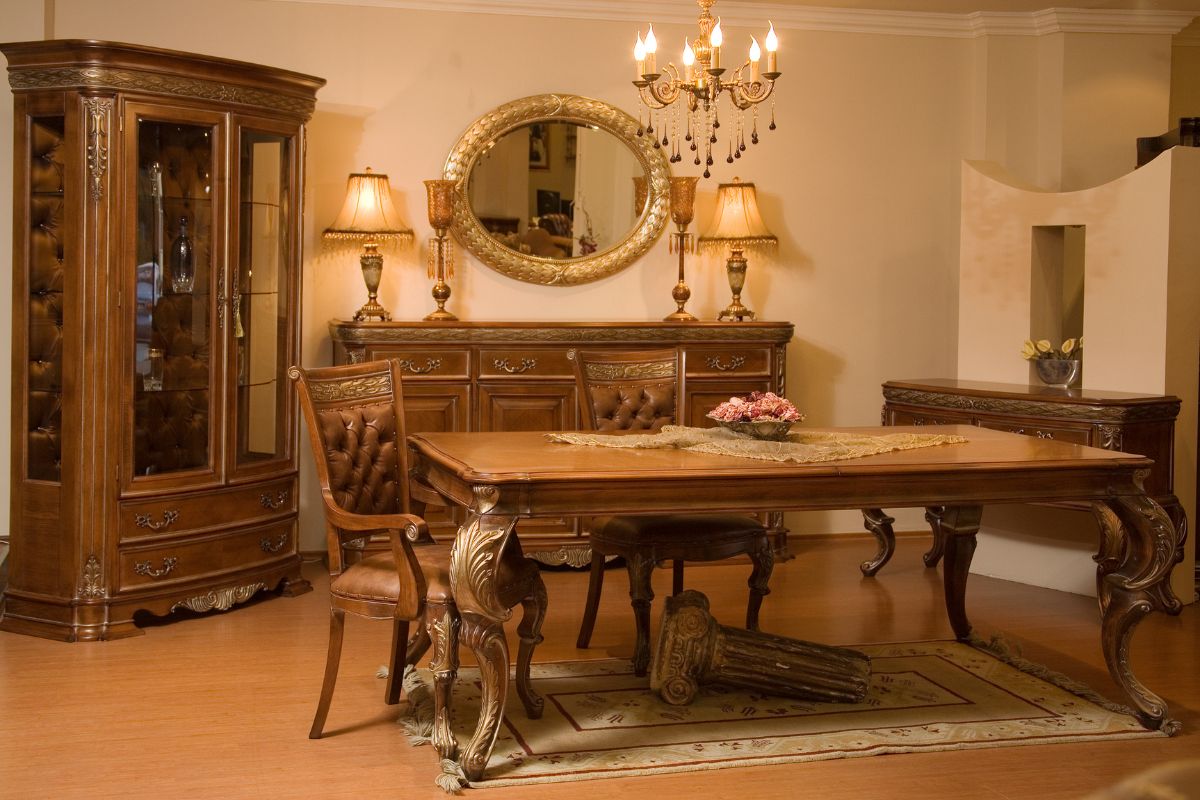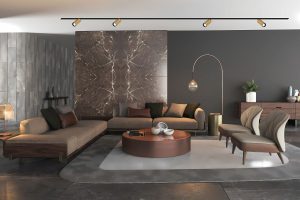With its rich hues and quality, cherry wood furniture beautifully contrasts modern minimalist interiors’ sleek and clean lines. This juxtaposition offers a captivating way to introduce warmth and elegance into your space. Its timeless appeal not only bridges the gap between traditional and contemporary design but also enriches any living space with its durable nature and a touch of natural artistry.
What are Modern Minimalist Interiors?
Modern minimalist interiors are a design philosophy that centers on simplicity and functionality. This style emphasizes clean lines, uncluttered spaces, and a monochromatic color palette that leans heavily on whites, grays, and other neutral tones. The goal is to create serene environments that are both aesthetically pleasing and utterly livable.
Core Principles of Minimalist Design
In minimalist design, every element has a purpose. Furniture is chosen not only for its functional value but also for its form.
Pieces are typically sleek and simple, avoiding ornate details that could clutter the visual space. This philosophy extends to decor—what is used often serves a dual purpose, combining function with discreet style.
- Space: The role of space in minimalist interiors cannot be overstated. Open, airy rooms are a trademark of this style, promoting a sense of tranquility and freedom.
- Light: Minimalist designs often feature large windows that allow natural light to flood the space. The light enhances the openness and the interplay of shadows and highlights throughout the day.
- Materials: Natural elements like wood, stone, and metal are favored for their texture and color in minimalist designs. These materials are chosen for their ability to age gracefully and for their inherent qualities rather than mere decorative appeal.
Characteristics of Cherry Wood Furniture
Cherry wood furniture is renowned for its unique characteristics. It boasts a smooth grain and rich, warm tones that deepen to a lustrous red-brown over time. This aging process, known as patination, enhances its beauty, making cherry wood pieces even more coveted as they age.
How to Identify Cherry Wood?
Here are some of the distinctive features of cherry wood that will help you differentiate it from other hardwoods:
- Color Changes Over Time: Cherry wood is well-known for its ability to darken slightly when exposed to light, a process known as oxidation. This enriches its hue, transitioning from a light pinkish-brown when freshly cut to a rich, reddish-brown as it ages.
- Fine Grain: Cherry wood has a fine, straight grain that can display patterns such as waves or curls, adding to its visual appeal. This smooth grain makes it ideal for finishes and detailed work.
- Workability: Cherry is a favorite among woodworkers due to its ease of use. It cuts cleanly, resists splintering, and can be easily shaped, making it ideal for intricate woodworking projects, including cabinetry and fine furniture.
- Durability and Stability: While not as hard as some hardwoods like oak, cherry still offers good durability and resistance to decay. It also possesses good dimensional stability, which means it resists warping and maintains its shape well over time.
- Excellent Finish Qualities: Cherry wood’s fine pores and density allow it to absorb stains and finish very evenly, enhancing its natural beauty and making it a great candidate for various finishes, such as oil, stain, or paint.
- Aging Gracefully: Unlike many other kinds of wood, cherry does not entirely darken; its rich patina develops a complex color palette over time that can vary depending on its specific environment, contributing to its uniqueness.
- Thermal Properties: Cherry wood has good insulating properties, making it a practical choice for furniture and kitchen utensils. It does not conduct heat as quickly as other woods or materials might.
Important Guidelines on Adding Cherry Wood into Minimalist Spaces
Incorporating cherry wood furniture into minimalist spaces not only enhances the aesthetic but also adds a practical and natural element that beautifully contrasts with the typical modern decor. To achieve a harmonious balance, consider the following guidelines:
Choosing Cherry Wood Pieces for Minimalist Aesthetics
When choosing cherry wood furniture for minimalist interiors, focus on pieces with streamlined shapes and subdued finishes. Opt for items with clean lines and minimal ornamentation to maintain the simplicity and openness that minimalist design demands.
Furniture like a cherry wood dining table or a smooth, well-crafted sideboard can be focal points without overwhelming the space. Opt for finishes highlighting the natural beauty of the wood while keeping the look understated—think matte or satin rather than glossy finishes, which help keep the piece from appearing too “loud” for a minimalist setting.
Pairing Cherry Wood with Other Woods
Mixing different types of wood furniture can add depth and interest to minimalist decor. However, it should be done carefully to maintain the balance within a space.
Consider the overall color palette and grain patterns to incorporate cherry wood with other wood types. Woods with similar finishes and hues can coexist perfectly.
For example, pairing cherry wood with walnut or mahogany can create a warm, inviting atmosphere as they all share a similar depth of color and grain complexity. You may also apply contrasts if you’re following a specific palette. However, ensure that the other wood types also feature simple, clean lines to keep the minimalist integrity intact.
Texture and Color in Minimalist Interiors
Texture and color are critical in balancing cherry wood’s warmth in minimalist spaces. Cherry wood naturally has a rich, warm hue, making a space more inviting.
To complement this warmth, incorporate textiles like wool throws or linen curtains in neutral tones that do not compete but soften and balance the richness of the wood.
Furthermore, using a color palette that includes shades of white, beige, gray, and black can help maintain a minimalist look while allowing the natural reds and browns of cherry wood to stand out as accents rather than overwhelm.
In terms of texture, combining the smooth, fine grain of cherry wood with rougher textures like jute rugs or concrete accents can enhance the minimalist theme by adding visual interest and tactile diversity without clutter.
Design Techniques and Room-Specific Advice
Adding cherry wood furniture into minimalist designs involves careful placement and color coordination to maintain the aesthetic’s clean and serene essence. Here are some room-specific design techniques that can help you integrate this richly-hued wood into various spaces within a minimalist home:
Living Room
The living room is a central hub for relaxation and social interaction, making it the perfect place to introduce cherry wood as a statement piece. Opt for cherry wood furniture with simple, clean lines, such as a coffee table or an entertainment console, to anchor the space without overwhelming it.
Pair these pieces with lighter fabrics and materials to keep the room feeling open and airy. For instance, a cherry wood coffee table can be complemented with a glass top, enhancing the room’s functionality and lightening the wood’s visual weight.
Use sparse, high-quality decorations to maintain a minimalist feel—think a single large vase or a sleek, modern sculpture.
Bedroom
In the bedroom, cherry wood can create a warm, inviting atmosphere essential for a restful environment. Opting for cherry wood bedroom sets from Amish Furniture Factory not only brings this warmth but also assures quality craftsmanship in significant pieces like bed frames and dressers.
Pair a cherry wood bed with neutral bedding—creamy whites or soft grays work beautifully—and minimalistic nightstands to balance the richness of the wood.
Consider soft lighting to enhance the cozy ambiance of the wood’s warm tones. Wall colors should also be kept neutral to draw attention to the furniture without causing a sensory overload.
Dining Area
For the dining area, a minimalist cherry wood dining set can serve as a functional meal space and a design element that ties the room together.
Choose a dining table with sleek, geometric lines and pair it with monochrome or earth-toned chairs that do not compete visually with its natural beauty. A minimalist approach to table settings and decor will help maintain the clean look—use simple dishware, a few central pieces like a low-profile centerpiece, and perhaps a neutral runner to add texture without clutter.
Lighting above the table should be kept simple, with a single, striking fixture that complements the modern aesthetic.
Recommendations: Accessorizing and Complementary Materials
Accessorizing your space with cherry wood furniture offers an opportunity to introduce warmth and texture while maintaining a minimalist aesthetic.
Here are some recommendations for textiles, rugs, and other accessories that can enhance the appeal of cherry wood without overwhelming the space, as well as advice on integrating other materials and choosing color schemes that complement the wood’s rich tones.
Textiles and Rugs
When selecting textiles and rugs to complement cherry wood furniture, opt for materials that provide a contrast in texture but harmony in color. Soft, plush textiles can soften the appearance of cherry wood’s smooth, glossy finish.
Consider using wool or cotton throws in neutral shades such as beige, taupe, or soft grays. These throws can be draped over sofas or chairs to add an extra layer of texture and warmth.
Rugs in subtle patterns or solid colors that do not overpower the room can define spaces without closing them in. For example, a large, light-colored rug under a cherry wood dining table can brighten the space and make it appear larger.
Complementary Materials: Metals, Glass, and Ceramics
Materials like metals, glass, and ceramics can add a modern touch and break up the monotony of wood textures in a room featuring cherry wood furniture.
- Metals: Incorporating sleek metallic elements such as stainless steel, brushed nickel, or even matte black fixtures (like lamp bases or frames) can introduce a contemporary flair. These metals contrast beautifully with the warm tones of cherry wood, providing a modern twist to traditional pieces.
- Glass: Using glass in tabletops, vases, or decorative items can lighten a space visually and add a clean, crisp element that complements the solidity of cherry wood.
- Ceramics: Matte or glazed ceramic accessories in neutral or muted tones can harmonize with cherry wood’s natural hues while adding an artisanal touch to the décor.
Color Coordination with Cherry Wood Furniture
The right color palette is crucial in enhancing the natural beauty of cherry wood without competing with it.
- Complementary Colors: Greens, blues, and earth tones traditionally pair well with cherry wood’s red tones. These colors complement the wood’s red hues and can balance the space.
- Wall Colors: Neutral wall colors such as light gray, cream, or even soft pastels can serve as a perfect backdrop, allowing cherry wood furniture to stand out without overwhelming the space. For a bolder look, consider navy or charcoal, which can highlight the furniture’s richness.
- Wood Pairings: As established earlier, aim for contrast and harmony when mixing cherry wood with other woods. Lighter woods like maple or birch can create a pleasant contrast, while darker woods should be used sparingly to avoid a heavy look. Woods with a similar grain pattern but different finishes can also work well together.
Bringing Tradition to Modernity: Cherry Wood in Minimalist Design
Strategically placing and pairing cherry wood enhances its natural beauty, ensuring it complements minimalist environments without overwhelming them. This balanced approach allows cherry wood’s unique characteristics to improve the overall aesthetic, adhering to minimalist principles.
Thoughtful consideration of space, color, and texture is vital to integrating cherry wood into minimalism, enriching the design with natural elegance while maintaining visual spaciousness.












